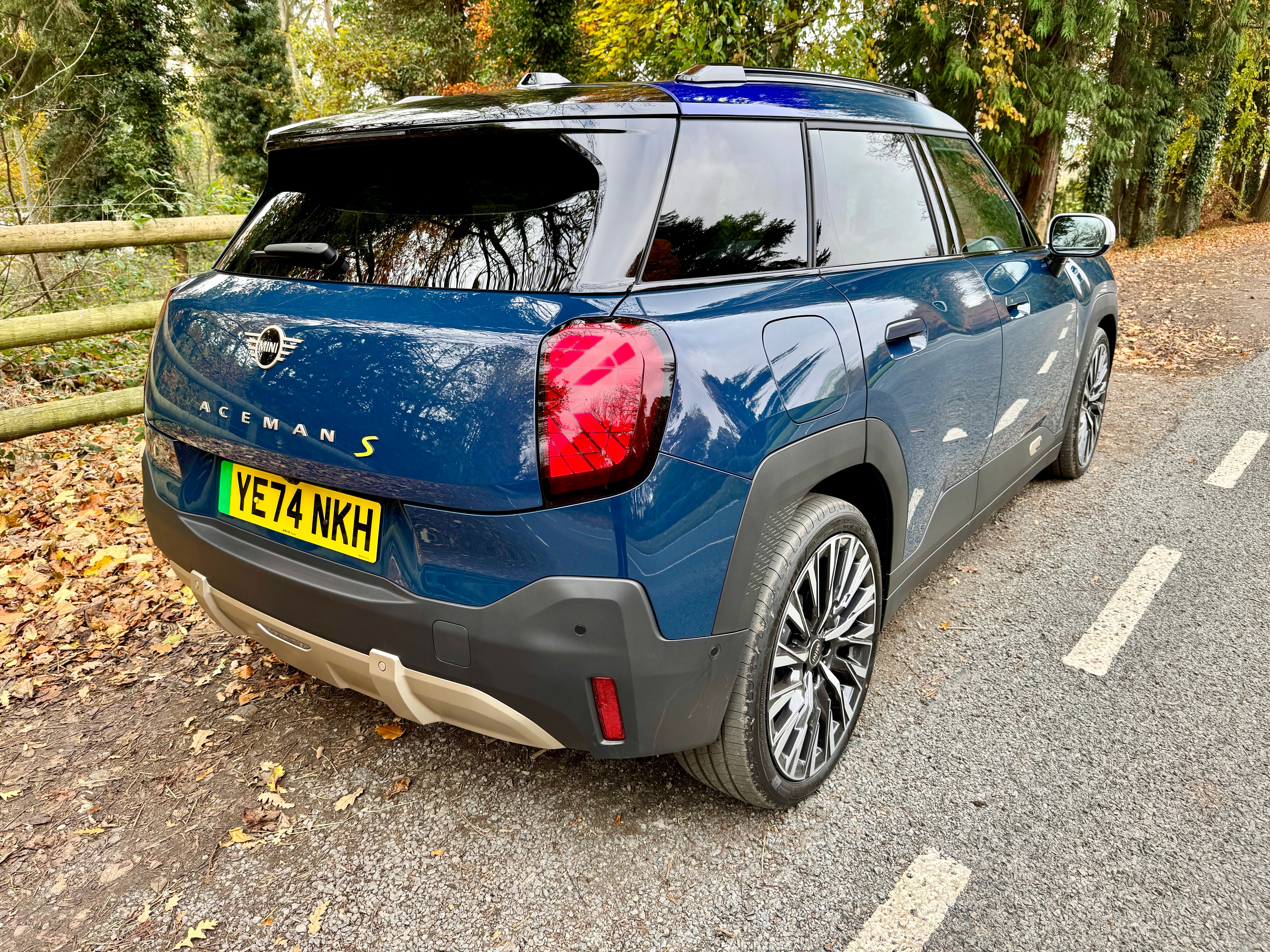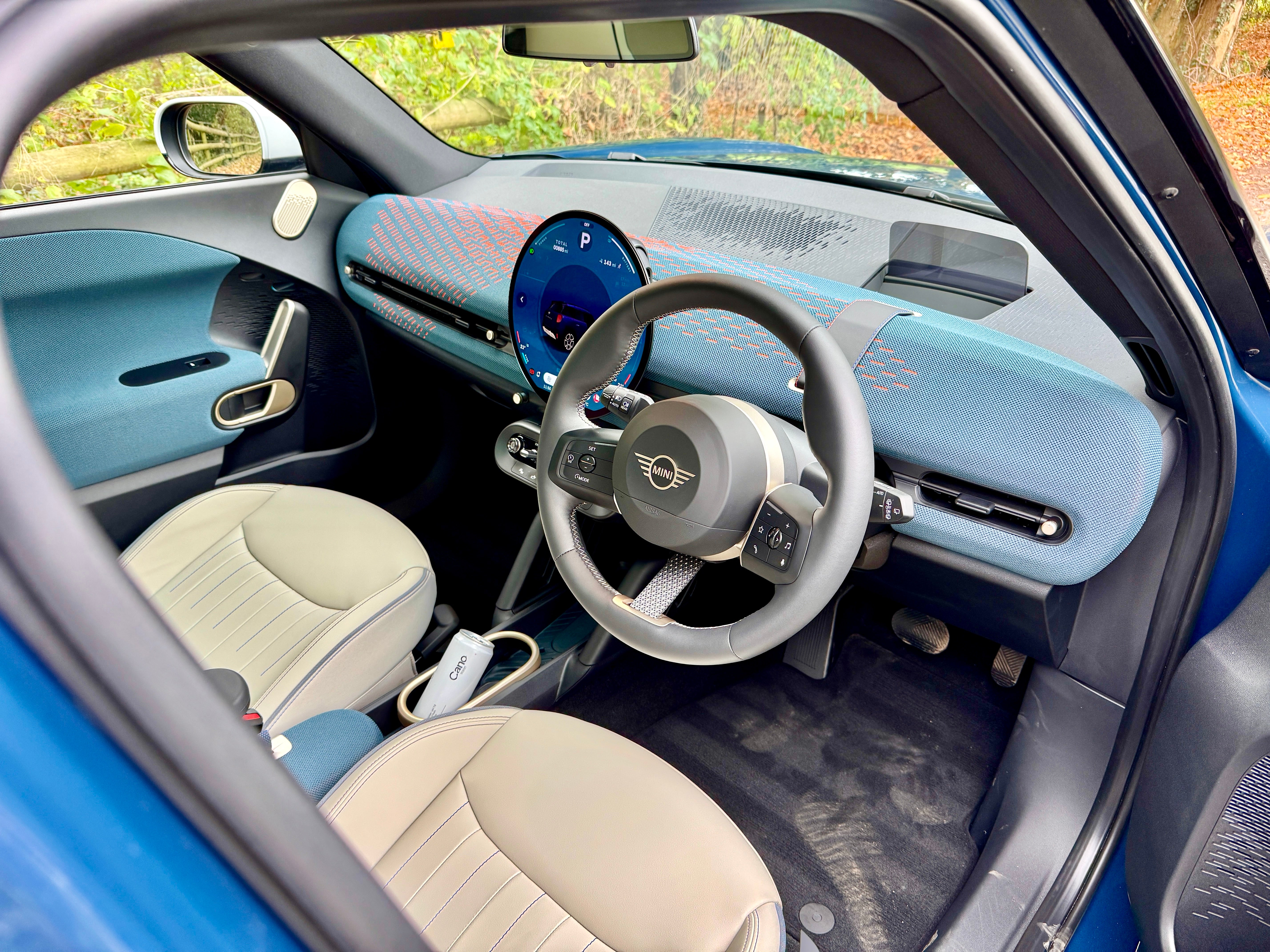
There’s a lot to like about the all-new electric Mini Aceman, from the reasonable price – less than £2,000 more than the smaller Mini Cooper – to the funky styling and characterful interior that has space for four full-size adults.
The Aceman also drives well, and feels quicker than the numbers might suggest. It hits a sweet spot in terms of dynamics between the firmer, sportier Mini Cooper and the bigger SUV-like Countryman. It’s still great fun to drive, but comfortable over the bumps, too.
We found it to be very efficient driving around Oxfordshire, while the infotainment system works well. The circular OLED central screen is certainly a show-stopper, but it takes a bit of getting used to.
Charge speeds aren’t great. At 70 kW the base model’s is actually worse than the also-slow Cooper. This is especially disappointing since the Aceman is an all-new car built to be exclusively electric. There’s also a fair bit of hard plastic in the otherwise-refined cabin, but the Aceman’s charm and distinctive styling still win us over.
How we tested
We spent a morning in the new Aceman driving it around the lanes, towns, motorways and villages in Oxfordshire. We also checked the space in the back and how usable the boot was, while driving on numerous different road surfaces that are typical of British roads.
Mini Aceman: From £31,800, Mini.co.uk

Independent rating: 9/10
Battery, range, charging, performance and drive
The new Aceman is the first Mini only to be offered as an EV, with no petrol or hybrid version available. As a five-door model, it effectively replaces the old five-door Minis, but also the unloved Clubman model. It slots between the slightly lower-priced Cooper hatchback and the larger, pricier Countryman SUV, and – with some body cladding and a slight SUV style – is described as a crossover for the premium small car segment.
You can choose your new mid-size Mini in three flavours: entry-level E, mid-spec SE and then a hot JCW John Cooper Works version. All have a single motor powering the front wheels and use a 400-volt electrical system. The E starts at £31,800 and has a 38.5 kWh battery pack with a claimed range of up to 192 miles and a 0-62 mph time of 7.9 seconds. It charges at a maximum rate of just 70 kW, for a 10-80 per cent charge time of 28 minutes.
Spend £36,300 and you get the Aceman SE, which has a larger 49.2 kWh battery, a longer range of up to 252 miles, a quicker 0-62 mph time of 7.1 seconds and speedier charging, but which still only manages 95 kW. A top-up from 10 to 80 percent takes 31 minutes.
At the top of the range is the recently revealed hot Aceman JCW, which uses the same battery as the SE but more power, cutting the 0-62mph time to 6.4 seconds. On the downside, the range drop to 243 miles.
The Aceman SE feels plenty quick enough at lower speeds and also provides a smoother and more comfortable ride than the firmer, sportier Cooper SE. It’s generally a pleasant, relaxing car to drive. Mini’s trademark go-kart handling is present and correct, too. The Aceman strikes a nice blend of being able to flow swiftly through corners and providing good feel through the steering wheel, yet remaining comfortable and impressively quiet, too.
Interior, practicality and boot space
The Aceman’s interior is roomier and more accessible than that of the Cooper, making it an attractive option for young families who have outgrown the three-door Mini.
The dashboard is broadly the same as the Cooper and Countryman – with that large circular OLED display at its centre – but Mini has let its designers have some fun here. Harking back to the Aceman concept from 2022, the production car has a fabric dashboard with multicoloured patterns, and details that look like luggage straps on the dash’ and steering wheel. It’s design for design’s sake, but gives the cabin a nice dose of character and warmth, while also adding to the premium feel that Minis have always had.
Rear seat space is much improved over the Cooper, with good knee room and adequate headroom even for adults. However, the glass panoramic roof of our test car, while a nice addition, seems to rob some headroom. It’s fine in the back, but obviously not as spacious as the larger Countryman. A 6ft passenger could sit behind an equally tall driver without too many complaints as long as the seat isn’t in its lowest setting; foot space under the seat can be limited. All versions of Aceman have 300 litres of boot space, but there’s no additional storage under the bonnet.

Technology, stereo and infotainment
Mini’s new circular OLED touchscreen is a clever (and attractive) bit of technology, but its user interface takes some getting used to. The system feels cluttered at first, but after a couple of hours behind the wheel you soon learn where everything is – like the settings menu – and how to interact with key controls like cabin temperature and the navigation system. Voice control works well to control many of the major functions, but it’s not without its foibles: we found the voice assistant would frequently interrupt conversations with our passenger, mistakenly thinking we were talking to it.
The built-in nav is good enough that we’d consider using it instead of Google Maps, although drivers will be reassured to know the Aceman comes with Apple CarPlay and Android Auto as standard. And yes, they actually look good on the circular screen, since their wallpapers fill the display and the car’s key controls remain visible at all times.
There are some delightful physical controls that hark back to the toggle controls in Minis of old, including a key-like switch for starting the car. There’s also a toggle for flicking between the Aceman’s many drive modes, including ‘go-kart’, complete with a ‘woo-hoo’ as you select it, plus optional sci-fi engine sound effects.
Upgrading to the level two options kit includes a decent Harman Kardon sound system, plus the aforementioned glass roof.
Prices and running costs
Despite it being noticeably larger than the Mini Cooper, the entry-level £31,800 Aceman is just £1,800 more expensive than the cheapest electric version of its smaller sibling. For drivers who want a Mini on their drive but need extra space – and slightly more range, too – the Aceman makes a lot of financial sense. It is equally as efficient as the smaller car, according to Mini’s own figures, so running costs should be about the same.
As always with an EV, running costs will depend largely on how much you pay for electricity at home, and how often you use pricier public chargers. During our previous drive of the Aceman on a four-hour route, the Aceman saw an average efficiency, according to the car’s own computer, of 13.9 kWh per 100 km. That’s 4.47 miles per kWh, which is a great result and even better than Mini’s own claim, although that driving route included very little motorway and we rarely went over 60 mph. A cruise at 70 mph in the UK or 80 mph in Europe will see that figure fall.

Mini Cooper E rivals
FAQs
How long does it take to charge?
The Mini Aceman isn’t particularly quick to charge. The E variant can only take on power at up to 70 kW, which is a little behind the smaller Mini Cooper, while the range-topping SE can only manage 90 kW. In both cases, a fill from 10 to 80 percent takes between at least 28 and 31 minutes. Filling from zero to 100 percent with a 7.4 kW home charge takes between about seven and nine hours.
How much does it cost - is it worth it?
Despite being larger, more practical and generally more grown up, the Aceman starts at just £1,800 more than the Mini Cooper, making it feel like good value.
Is there a petrol version of the Mini Aceman?
No. Unlike the smaller Mini Cooper and larger Mini Countryman, which are both available with the choice of petrol engines or electric motors, the Aceman is exclusively an EV.
The verdict: Mini Cooper Aceman
The Aceman is the sweet spot in the new three-car Mini range. It’s more practical than the new Mini Cooper, but not as bloated as the new Mini Countryman. We think it drives better than both. It’s as fun as a Mini should be, while being comfortable and refined on British roads. It’s also got a well-made and characterful interior that makes it even more loveable.







